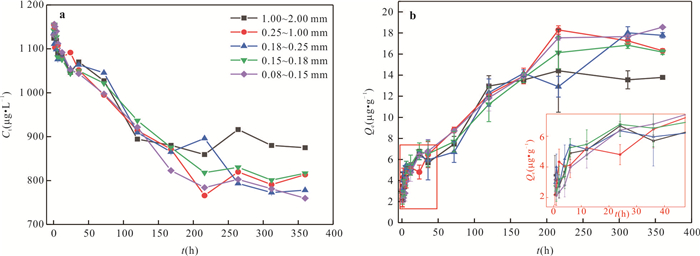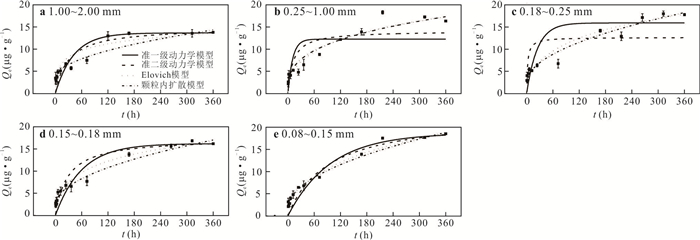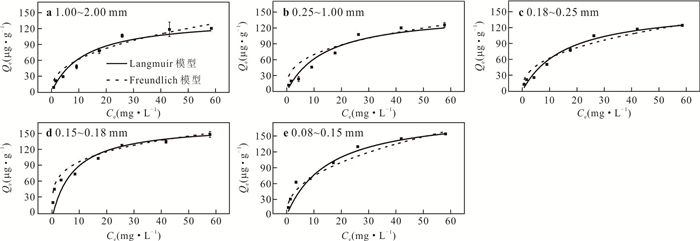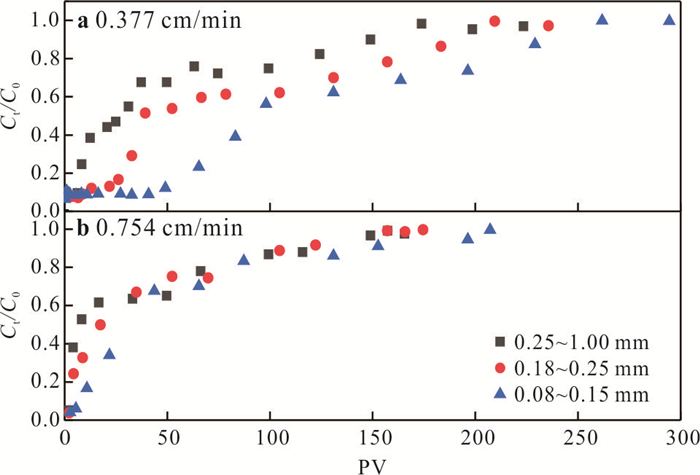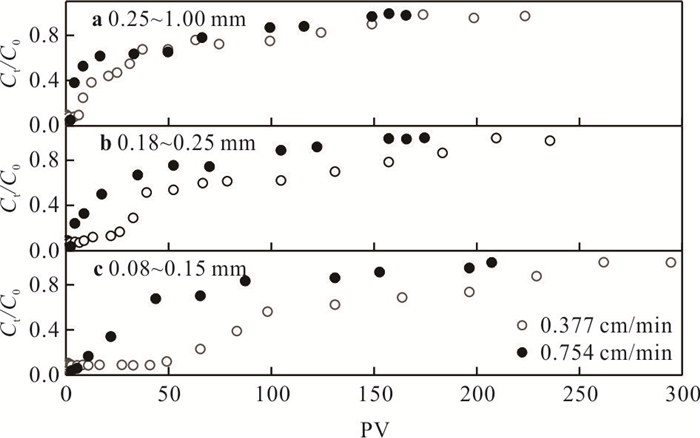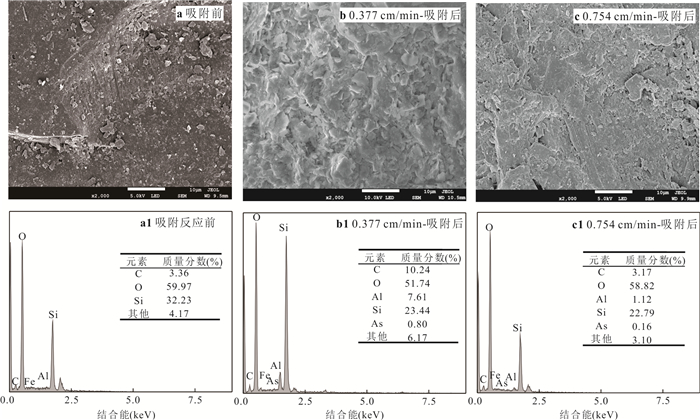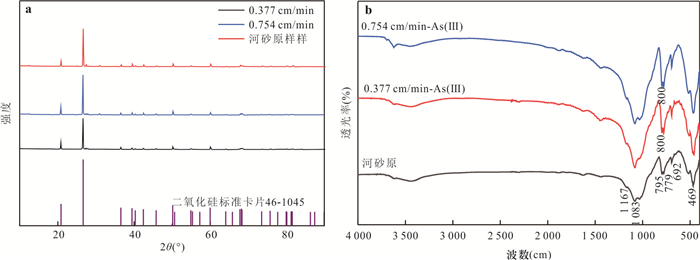Experiment on Influence of Flow Velocity and Medium Particle Size on As(Ⅲ) Migration
-
摘要: 为了解潜流带中地下水流速和介质颗粒对As(Ⅲ)迁移的影响,选用天然河砂为介质,配制地下水含As(Ⅲ)模拟液,开展室内批实验和动态柱实验并进行表征分析,探讨流速和介质粒径对As(Ⅲ)迁移的影响及机制.结果发现:(1)粒径越小的河砂与As(Ⅲ)相互作用平衡时间越长,As(Ⅲ)的单位吸附量(Qe)随着河砂粒径的增大而减小(0.15~0.18 mm的粒径河砂除外),单层最大吸附量(Qm)随着粒径的增大呈减小趋势;(2)As(Ⅲ)在河砂上的迁移行为表现出明显的粒径和流速效应;一方面,河砂粒径越小,比表面积越大,增加了水-砂相互作用时间和限制了地下水冲洗速度,不利于As(Ⅲ)在河砂中的迁移;另一方面,流速越大导致空隙通道内的水力剪切力增强,紊流强度的提高减小了滞留边界层厚度,利于As(Ⅲ)在河砂中的迁移.Abstract: To understand the influence of groundwater velocity and medium particles on As(Ⅲ) migration in the riparian zone, natural river sand is selected as the medium, and groundwater solutions containing As(Ⅲ) as commonly seen in some riparian zones are prepared to carry out batch experiments and dynamic column experiments. Combing with the characterization analysis, the influence and mechanism of velocity and medium particle size on As(Ⅲ) migration are discussed. The results show follows: (1) The adsorption equilibrium time of As(Ⅲ) is longer for the smaller particle size of river sand. The equilibrium adsorption capacity (Qe) of As (Ⅲ) on the river sand decreases with the increase of its particle sizes (except for river sand with a particle size of 0.15-0.18 mm), and the maximum amount (Qm) of monolayer adsorption shows a decreasing trend with the increase of particle size. (2) As(Ⅲ) migration in the column filled with river sand is significantly affected by the particle size and velocity. On one hand, the river sand of the smaller particle size has a larger specific surface area, which usually leads to longer interaction time between aqueous solutions and solid medium, thus limiting the groundwater flushing rate. This is not conducive to the migration of As(Ⅲ) in river sand. On the other hand, the higher flowing velocity leads to a stronger hydraulic shear force in the void channel. Meanwhile, the increase of turbulence intensity reduces the thickness of the retained boundary layer, which is conducive to the migration of As(Ⅲ) in river sand.
-
Key words:
- flow rate /
- particle size /
- As(Ⅲ) /
- migration /
- hydrogeology
-
表 1 河砂及模拟液主要成分
Table 1. Main components of river sand and simulated liquid
河砂 含量(%) 模拟液 浓度(mg/L) 模拟液 浓度及特性 SiO2 90.69 DO < 2 CO32-(mg/L) - Al2O3 5.91 K+ 0.312 pH 8.27 K2O 1.62 Ca2+ 59.53 Eh(mV) 253.7 Fe2O3 1.51 Na+ 4.18 EC(μS/cm) 254 CaO 0.32 Mg2+ 7.61 TiO2 0.17 Cl- 9.52 MgO 0.15 NO3- 3.54 Na2O 0.14 SO42- 15.66 MnO 0.06 HCO3- 179.7 表 2 各砂柱实验参数
Table 2. Sand column experimental parameters
流速(cm/min) 粒径(mm) 孔隙体积(cm3) 河砂质量(g) 平均比表面积(m2/g) 0.377/0.754 0.25~1.00 29.0 133.071 9 0.641 0.18~0.25 27.5 128.468 1 1.174 0.08~0.15 22.0 123.781 7 1.396 表 3 动力学吸附模型
Table 3. Kinetic sorption models
模型名称 方程 模型参数 参考文献 准一级动力学 $ {Q}_{\mathrm{t}}={Q}_{\mathrm{e}}(1-{\mathrm{e}}^{-{K}_{1}t}) $ 一级吸附速率常数(K1) Lagergren(1898) 平衡吸附量(Qe) 准二级动力学 Qt=$ \frac{{Q}_{\mathrm{e}}^{2}{K}_{2}t}{1+{Q}_{\mathrm{e}}{K}_{2}t} $ 二级吸附速率常数(K2) Ho and McKay(1999) 颗粒内扩散模型 $ {Q}_{\mathrm{t}}={K}_{1}{t}^{\frac{1}{2}}+C $ 内扩散速率常数(KI) Jr Weber and Morris(1963) 常量(C) Elovich Qt=βIn(αβ)+βIn(t) 常量(β) Low(1960) 常量(α) Freundlich $ {Q}_{\mathrm{e}}={K}_{\mathrm{F}}{C}_{\mathrm{e}}^{\frac{1}{n}} $ 吸附能力相关常数(KF) Namasivayam and Senthilkumar(1998) 吸附能相关常数(n) Langmuir Qe=$ \frac{{Q}_{\mathrm{m}}{K}_{\mathrm{L}}{C}_{\mathrm{e}}}{1+{K}_{\mathrm{L}}{C}_{\mathrm{e}}} $ 吸附能相关常数(KL) Langmuir(1918) 吸附平衡时吸附质的质量浓度(Ce) 表 4 河砂对As(Ⅲ)的吸附动力学拟合参数
Table 4. Kinetic parameters for As(Ⅲ) adsorption on river sand
模型 参数 粒径(mm) 1.00~2.00 0.25~1.00 0.18~0.25 0.15~0.18 0.08~0.15 准一级动力学 Qe(µg/g) 13.647 12.260 15.921 16.201 18.677 K1 0.024 0.092 0.041 0.017 0.010 R2 0.871 0.924 0.584 0.925 0.954 准二级动力学 Qe(µg/g) 14.902 14.127 12.666 17.447 23.054 K2 0.002 0.006 0.034 0.002 0.000 R2 0.898 0.943 0.687 0.942 0.964 颗粒内扩散模型 C 3.286 2.295 2.372 2.256 1.623 KI 0.582 0.880 0.837 0.778 0.908 R2 0.930 0.991 0.992 0.982 0.987 Elovich β 2.158 5.315 5.508 4.293 7.305 α 0.684 0.012 0.012 0.030 0.004 R2 0.906 0.990 0.992 0.989 0.988 表 5 Langmuir和Freundlich等温吸附模型拟合参数
Table 5. Fitting parameters by Langmuir isotherm and Freundlich isotherm models
粒径(mm) Langmuir Freundlich KL(10-4 L/g) Qm(µg/g) R2 KF/(mg1-1/n·L1/n·g-1) n R2 1.00~2.00 0.082 140.350 0.967 24.048 2.427 0.940 0.25~1.00 0.070 149.875 0.824 32.154 2.972 0.757 0.18~0.25 0.062 158.655 0.981 25.123 2.531 0.942 0.15~0.18 0.127 167.976 0.870 59.312 4.326 0.923 0.08~0.15 0.064 195.698 0.968 27.605 2.325 0.981 -
Akpomie, K. G., Dawodu, F. A., Adebowale, K. O., 2015. Mechanism on the Sorption of Heavy Metals from Binary-Solution by a Low Cost Montmorillonite and Its Desorption Potential. Alexandria Engineering Journal, 54(3): 757-767. https://doi.org/10.1016/j.aej.2015.03.025 Benner, S. G., Polizzotto, M. L., Kocar, B. D., et al., 2008. Groundwater Flow in an Arsenic-Contaminated Aquifer, Mekong Delta, Cambodia. Applied Geochemistry, 23(11): 3072-3087. https://doi.org/10.1016/j.apgeochem.2008.06.013 Berg, M., Stengel, C., Trang, P. T. K., et al., 2007. Magnitude of Arsenic Pollution in the Mekong and Red River Deltas-Cambodia and Vietnam. Science of the Total Environment, 372(2/3): 413-425. https://doi.org/10.1016/j.scitotenv.2006.09.010 Bouzekri, S., El Hachimi, M. L., Touach, N., et al., 2019. The Study of Metal (As, Cd, Pb, Zn and Cu) Contamination in Superficial Stream Sediments around of Zaida Mine (High Moulouya-Morocco). Journal of African Earth Sciences, 154: 49-58. https://doi.org/10.1016/j.jafrearsci.2019.03.014 Cao, Y. S., Guo, H. M., Ni, P., et al., 2017. Influences of Sediments Geochemical Characteristics and Land Utilization on Groundwater Arsenic Activities. Earth Science Frontiers, 24(2): 274-285(in Chinese with English abstract). Chen, H. S., Sun, Z. Y., Shao, J. C., 2011. Investigation on FT-IR Spectroscopy for Eight Different Sources of SiO2. Bulletin of the Chinese Ceramic Society, 30(4): 934-937(in Chinese with English abstract). Chen, Z., 2018. Study on the Contaminant Migration in the Layered Heterogeneous Aquifers during the Pollution and Hydrodynamics Remediation Process (Dissertation). Jilin University, Changchun (in Chinese with English abstract). Freikowski, D., Neidhardt, H., Winter, J., et al., 2013. Effect of Carbon Sources and of Sulfate on Microbial Arsenic Mobilization in Sediments of West Bengal, India. Ecotoxicology and Environmental Safety, 91: 139-146. https://doi.org/10.1016/j.ecoenv.2013.01.021 Gerdelidani, A. F., Towfighi, H., Shahbazi, K., et al., 2021. Arsenic Geochemistry and Mineralogy as a Function of Particle-Size in Naturally Arsenic-Enriched Soils. Journal of Hazardous Materials, 403: 123931. https://doi.org/10.1016/j.jhazmat.2020.123931 Goldberg, S., Johnston, C. T., 2001. Mechanisms of Arsenic Adsorption on Amorphous Oxides Evaluated Using Macroscopic Measurements, Vibrational Spectroscopy, and Surface Complexation Modeling. Journal of Colloid and Interface Science, 234(1): 204-216. https://doi.org/10.1006/jcis.2000.7295 Gude, J. C. J., Rietveld, L. C., van Halem, D., 2018. As(Ⅲ) Removal in Rapid Filters: Effect of pH, Fe(II)/Fe(Ⅲ), Filtration Velocity and Media Size. Water Research, 147: 342-349. https://doi.org/10.1016/j.watres.2018.10.005 Guo, H. M., Ni, P., Jia, Y. F., et al., 2014. Types, Chemical Characteristics and Genesis of Geogenic High-Arsenic Groundwater in the World. Earth Science Frontiers, 21(4): 1-12 (in Chinese with English abstract). Guo, H. M., Zhang, D., Ni, P., et al., 2017. On the Scalability of Hydrogeochemical Factors Controlling Arsenic Mobility in Three Major Inland Basins of P. R. China. Applied Geochemistry, 77: 15-23. https://doi.org/10.1016/j.apgeochem.2016.05.006 He, J. W., Li, W. X., Chen, S., et al., 2019. Comparison of Removal and Migration Behavior of As(Ⅴ) and As(Ⅲ) in Solution on Taojiang Manganese Ore, Hunan Province. Environmental Chemistry, 38(8): 1801-1810(in Chinese with English abstract). He, M. J., Yang, Z. H., Wei, S. Q., 2019. Absorption Characterization and the Identification of Factors Influencing Five Organophosphate Esters in Water-Soil System. Huanjing Kexue, 40(10): 4604-4610. https://doi.org/10.13227/j.hjkx.201903215 Ho, Y. S., McKay, G., 1999. Pseudo-Second Order Model for Sorption Processes. Process Biochemistry, 34(5): 451-465. https://doi.org/10.1016/S0032-9592(98)00112-5 Huang, T. L., 1995. Kinetics and Experimental Study on Heavy Metal Release from Water Sediments. Acta Scientiae Circumstantiae, 15(4): 440-446 (in Chinese with English abstract). doi: 10.3321/j.issn:0253-2468.1995.04.001 Lagergren, S., 1898. Zur Theorie Der Sogenannten Adsorption Gelster Stoffe. Kungliga Svenska Vetenskapsakademiens, 24: 1-39. http://doi.org/10.1007/BF01501332 Langmuir, I., 1918. The Adsorption of Gases on Plane Surfaces of Glass, Mica and Platinum. Journal of the American Chemical Society, 40: 1361-1403. https://doi.org/10.1021/JA02242A004 Liao, D. X., Shan, H. M., Peng, S. X., et al., 2020. Characteristics and Mechanism of Monothioarsenate Adsorption on Sand, Sediment, and Goethite. Environmental Science, 41(1): 284-292 (in Chinese with English abstract). Lin, T. Y., Hafeznezami, S., Rice, L., et al., 2017. Arsenic Oxyanion Binding to NOM from Dung and Aquaculture Pond Sediments in Bangladesh: Importance of Site-Specific Binding Constants. Applied Geochemistry, 78: 234-240. https://doi.org/10.1016/j.apgeochem.2016.12.026 Liu, C. X., Shang, J. Y., Shan, H. M., et al., 2014. Effect of Subgrid Heterogeneity on Scaling Geochemical and Biogeochemical Reactions: A Case of U(VI) Desorption. Environmental Science & Technology, 48(3): 1745-1752. https://doi.org/10.1021/es404224j Low, M., 1960. Kinetics of Chemisorption of Gases on Solids. Chemical Reviews, 60(3): 267-312. http://doi.org/10.1021/cr60205a003 Lu, C. P., 2014. Study on the Synthesis of Magnetic Polystyrene Based Macroporous Resins and Their Adsorption Performance to Metal Ions in Aqueous Solution (Dissertation). Lanzhou University of Technology, Lanzhou (in Chinese with English abstract). Mandal, B. K., Suzuki, K. T., 2002. Arsenic Round the World: A Review. Talanta, 58(1): 201-235. https://doi.org/10.1016/S0039-9140(02)00268-0 Michael, H. A., Khan, M. R., 2016. Impacts of Physical and Chemical Aquifer Heterogeneity on Basin-Scale Solute Transport: Vulnerability of Deep Groundwater to Arsenic Contamination in Bangladesh. Advances in Water Resources, 98: 147-158. https://doi.org/10.1016/j.advwatres.2016.10.010 Namasivayam, C., Senthilkumar, S., 1998. Removal of Arsenic (V) from Aqueous Solution Using Industrial Solid Waste: Adsorption Rates and Equilibrium Studies. Industrial & Engineering Chemistry Research, 37(12): 4816-4822. https://doi.org/10.1021/ie970774x Park, S. G., Yahata, H., Saeki, K., et al., 2009. Physical Properties of Water Treatment Residue and Their Effects on Plant Growth as a Substitute Soil. Journal of the Faculty of Agriculture, Kyushu University, 54(2): 481-487. http://doi.org/10.1017/S002185960999013X Rahman, M. M., Naidu, R., Bhattacharya, P., 2009. Arsenic Contamination in Groundwater in the Southeast Asia Region. Environmental Geochemistry and Health, 31(1): 9-21. https://doi.org/10.1007/s10653-008-9233-2 Shang, J. Y., Liu, C. X., Wang, Z. M., et al., 2011. Effect of Grain Size on Uranium(VI) Surface Complexation Kinetics and Adsorption Additivity. Environmental Science & Technology, 45(14): 6025-6031. https://doi.org/10.1021/es200920k Stolze, L., Rolle, M., 2022. Surface Complexation Reactions in Sandy Porous Media: Effects of Incomplete Mixing and Mass-Transfer Limitations in Flow-through Systems. Journal of Contaminant Hydrology, 246: 103965. https://doi.org/10.1016/j.jconhyd.2022.103965 Sun, D. Y., Zhu, D. B., 2019. Environment Contrast and Genesis Analysis of High Arsenic Groundwater in the Northwestern China. Resources Environment & Engineering, 33(3): 387-390 (in Chinese with English abstract). Wang, Y., Shen, F., Qi, X. H., 2016. A Corn Stalk-Derived Porous Carbonaceous Adsorbent for Adsorption of Ionic Liquids from Aqueous Solution. RSC Advances, 6(39): 32505-32513. https://doi.org/10.1039/C6RA06908H Weber, W. J., Morris, J. C., 1963. Kinetics of Adsorption on Carbon from Solution. Journal of the Sanitary Engineering Division, 89(2): 31-59. https://doi.org/10.1061/JSEDAI.0000430 Xu, Y. X., Zheng, T. L., Gao, J., et al., 2021. Effect of Indigenous Sulfate Reducing Bacteria on Arsenic Migration in Shallow Aquifer of Jianghan Plain. Earth Science, 46(2): 652-660 (in Chinese with English abstract). Yamani, J. S., Lounsbury, A. W., Zimmerman, J. B., 2016. Towards a Selective Adsorbent for Arsenate and Selenite in the Presence of Phosphate: Assessment of Adsorption Efficiency, Mechanism, and Binary Separation Factors of the Chitosan-Copper Complex. Water Research, 88: 889-896. https://doi.org/10.1016/j.watres.2015.11.017 Yu, Q., Zhang, Y., Dong, T., et al., 2023. Effect of Surface Water-Groundwater Interaction on Arsenic Transport in Shallow Groundwater of Jianghan Plain. Earth Science, 48(9): 3420-3431(in Chinese with English abstract). Zhang, L., Guo, C. H., Ran, H. Z., et al., 2021. Particle Size and Occurrence Characteristics of Arsenic in River Sediments of Arsenic-Bearing Mine Areas. Environmental Engineering, 39(12): 38-43, 119(in Chinese with English abstract). Zhi, C. S., Chen, H. H., Li, P., et al., 2019. Spatial Distribution of Arsenic along Groundwater Flow Path in Chaobai River Alluvial-Proluvial Fan, North China Plain. Environmental Earth Sciences, 78(8): 259. https://doi.org/10.1007/s12665-019-8260-x 曹永生, 郭华明, 倪萍, 等, 2017. 沉积物地球化学特征和土地利用方式对地下水砷行为的影响. 地学前缘, 24(2): 274-285. https://www.cnki.com.cn/Article/CJFDTOTAL-DXQY201702034.htm 陈和生, 孙振亚, 邵景昌, 2011. 八种不同来源二氧化硅的红外光谱特征研究. 硅酸盐通报, 30(4): 934-937. 陈震, 2018. 层状非均质含水层污染与水动力修复过程中污染物的迁移规律研究(硕士学位论文). 长春: 吉林大学. 郭华明, 倪萍, 贾永锋, 等. 2014. 原生高砷地下水的类型, 化学特征及成因. 地学前缘, 21: 1-12. 何剑汶, 李文旭, 谌书, 等, 2019. 湖南桃江锰矿对溶液中As(Ⅴ)和As(Ⅲ)的去除及迁移行为对比. 环境化学, 38(8): 1801-1810. https://www.cnki.com.cn/Article/CJFDTOTAL-HJHX201908014.htm 黄廷林, 1995. 水体沉积物中重金属释放动力学及试验研究. 环境科学学报, 15(4): 440-446. doi: 10.3321/j.issn:0253-2468.1995.04.001 廖丹雪, 单慧媚, 彭三曦, 等, 2020. 一硫代砷酸盐在介质上的吸附特征及机制. 环境科学, 41(1): 284-292. https://www.cnki.com.cn/Article/CJFDTOTAL-HJKZ202001032.htm 路翠萍, 2014. 磁性聚苯乙烯基大孔树脂的制备及对水溶液中金属离子的吸附性能研究(硕士学位论文). 兰州: 兰州理工大学. 孙丹阳, 朱东波, 2019. 中国西北地区高砷地下水赋存环境对比及其成因分析. 资源环境与工程, 33(3): 387-390. https://www.cnki.com.cn/Article/CJFDTOTAL-HBDK201903019.htm 徐雨潇, 郑天亮, 高杰, 等, 2021. 江汉平原浅层含水层中土著硫酸盐还原菌对砷迁移释放的影响. 地球科学, 46(2): 652-660. doi: 10.3799/dqkx.2020.063 余倩, 张宇, 董听, 等, 2023. 地表水-地下水相互作用对砷在浅层地下水系统中运移的影响. 地球科学, 48(9): 3420-3431. doi: 10.3799/dqkx.2022.146 张鹂, 郭朝晖, 冉洪珍, 等. 2021. 含砷矿区河流沉积物粒径组成及砷赋存特征. 环境工程, 39(12): 38-43, 119. https://www.cnki.com.cn/Article/CJFDTOTAL-HJGC202112006.htm -









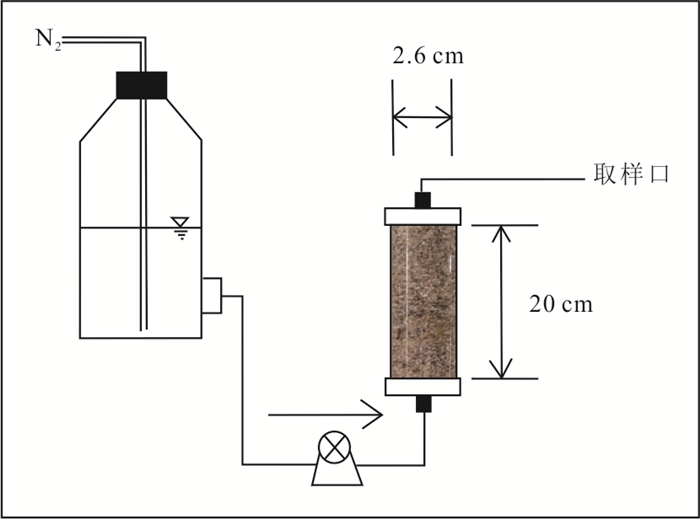
 下载:
下载:
